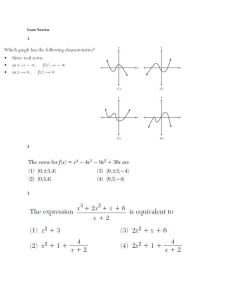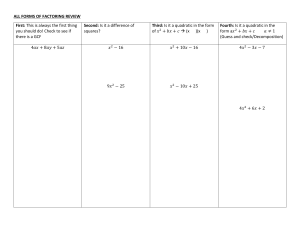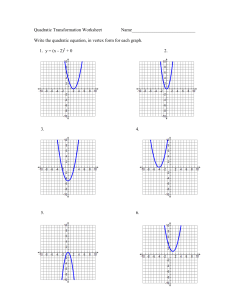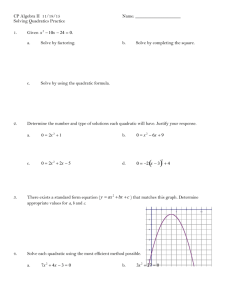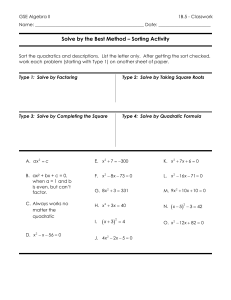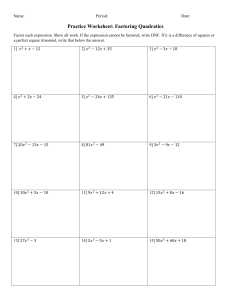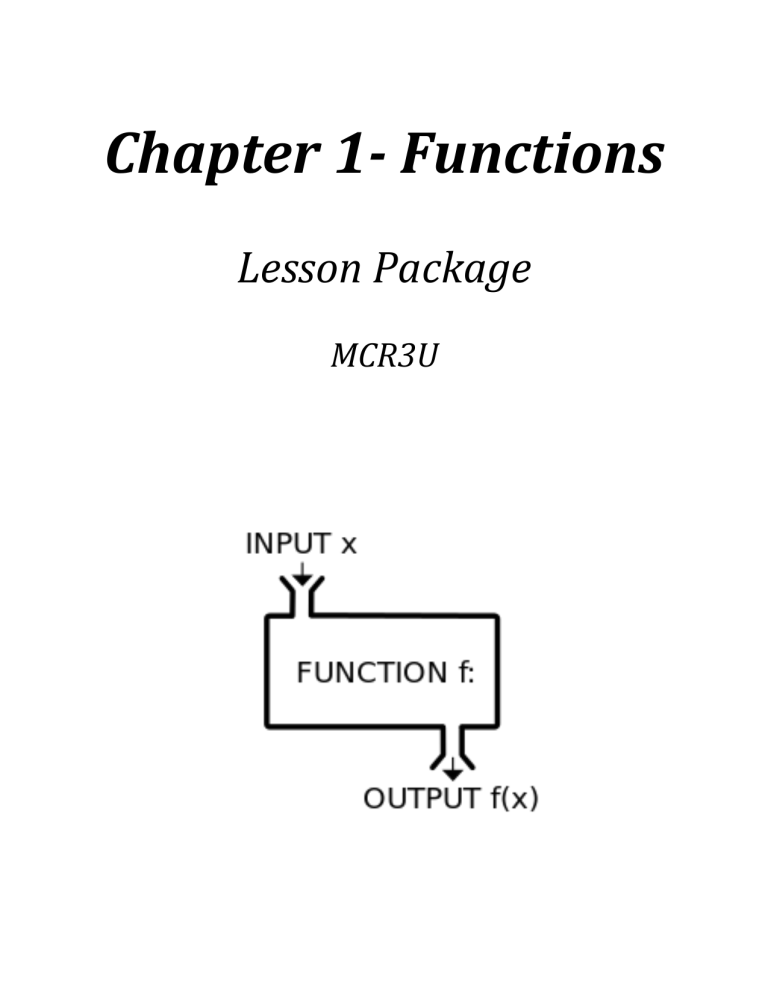
Chapter 1- Functions
Lesson Package
MCR3U
Chapter 1 Outline
Unit Goal: By the end of this unit, you will have an understanding of what a function is and their different
representations. You will be able to determine the zeros and the max or min of a quadratic function. You
will also be able to simplify expressions involving radicals.
Section
Subject
L1
Functions, Domain,
and Range
L2
Function Notation
L3
Max or Min of a
Quadratic
L4
Radical Expressions
L5
L6
L8
- distinguish a function from a relation
- explain meanings of the terms domain and range
Assessments
Note Completion
Practice Worksheet
Completion
Quiz – Max/Min of Quadratic
PreTest Review
Test - Functions
A1.1
- explain the meaning of the term function
- represent functions using function notation
- determine the max or min value of a quadratic function using
completing the square and partial factoring
Solve Quadratics by
Factoring
Solve Quadratics using
Quaratic Formula
Linear Quadratic
Systems
Curriculum
Expectations
Learning Goals
A1.1, A1.2
A2.2, A2.3
- simplify radical expressions by adding, subtracting, and
multiplying
A3.2
- Determine the zeros of a quadratic by factoring
A2.1, A2.3
- Determine the zeros of a quadratic using the quadratic formula
A2.1, A2.3
- Solve problems involving the intersection of a linear function and a
quadratic function
F/A/O
A
Ministry Code
P/O/C
P
F/A
P
F
F/A
P
P
O
A1.1, A1.2, A2.1, A2.2, A2.3,
A2.5, A3.2
P
A2.5
KTAC
K(21%), T(34%), A(10%),
C(34%)
1.1 Functions, Domain, and Range - Lesson
MCR3U
Jensen
Section 1: Relation vs. Function
Definitions
Relation –
an identified pattern between two variables that may be represented as a table of
values, a graph, or an equation.
Functions –
a relation in which each of value of the independent variable (x), corresponds to
exactly one value of the dependent variable (y)
Note: All functions are relations but not all relations are functions. For a relation to be a
function, there must be only one 'y' value that corresponds to a given 'x' value.
Function or Relation Investigation
1) Complete the following tables of values for each relation:
𝑦 = 𝑥!
𝒙
𝑥 = 𝑦!
𝒚
𝒙
𝒚
−3
−3
−2
−2
−1
−1
0
0
1
1
2
2
3
3
2) Graph both relations
𝑦 = 𝑥!
𝑥 = 𝑦!
3) Draw the vertical lines 𝑥 = −2, 𝑥 = −1, 𝑥 = 0, 𝑥 = 1, and 𝑥 = 2 on the graphs above.
4) Compare how the lines drawn in step 3 intersect each of the relations. Which relation is a function?
Explain why.
For y = x2 , none of the vertical lines drawn intersect the graph at more than one point. That means that for
each value of x, there is only 1 corresponding value of y. This means it is a function.
For x = y2 , some of the vertical lines drawn intersect the graph at more than one point. That means that some
x-values correspond to more than one y-value. This means it is NOT a function.
Section 2: Vertical Line Test
Vertical line test:
a method for determining if a relation is a function or not. If every possible vertical line
intersects the graph of the relation at only one point, then the relation is a function.
Example 1: Use the vertical line test to determine whether each relation is a function or not.
a)
b)
Not a function
When x = 6, y = 0 and 4
Function
c)
d)
Function
Not a function
When x = 1, y = -5 and 3
Section 3: Domain and Range
For any relation, the set of values of the independent variable (often the x-values) is called the
_____________________ of the relation. The set of the corresponding values of the dependent variable (often
the y-values) is called the ________________ of the relation.
Note: For a function, for each given element of the domain there must be exactly one element in the range.
Domain:
values x may take
Range:
values y may take
General Notation
Real number: a number in the set of all integers, terminating decimals, repeating decimals, nonterminating decimals, and non repeating decimals. Represented by the symbol ℝ
Example 2: Determine the domain and range of each relation from the data given.
a)
{ (-3, 4), (5, -6), (-2, 7), (5, 3), (6, -8) }
b)
𝑨𝒈𝒆
𝑵𝒖𝒎𝒃𝒆𝒓
4
8
5
12
6
5
7
22
8
14
9
9
10
11
Are each of these relations functions?
part a) is NOT a function. There are multiple y-values that correspond to an x-value of 5
part b) is a function. Each value for x has exactly one value for y.
Example 3: Determine the domain and range of each relation. Graph the relation first.
a) 𝑦 = 2𝑥 − 5
b) 𝑦 = (𝑥 − 1)! + 3
c)
𝑦 = √𝑥 − 1 + 3
d)
𝑥 ! + 𝑦 ! = 36
e)
"
𝑦 = #$%
Asymptotes
Asymptote:
The function 𝒚 =
𝟏
has two asymptotes:
𝒙$𝟑
Vertical Asymptote: Division by zero is undefined. Therefore the expression in the denominator of the
function can not be zero. Therefore x ≠ -3. This is why the vertical line x = -3 is an asymptote for this
function.
Horizontal Asymptote: For the range, there can never be a situation where the result of the division is
zero. Therefore the line y = 0 is a horizontal asymptote. For all functions where the denominator is a
higher degree than the numerator, there will by a horizontal asymptote at y = 0.
L2 - 1.2 Functions and Function Notation
MCR3U
Jensen
Part 1: Domain & Range Review
a) State the domain and range of the relation shown in the following graph:
b) Is this a function?
No, it does NOT pass the vertical line test.
c) What determines if a relation is a function or not?
For each value of x, there can only be one corresponding value of y.
d) How does the vertical line test help us determine if a relation is a function?
If any vertical line touches the graph of the relation in more than one spot, it is NOT a function.
e) What is domain?
The values x may take.
f) What is range?
The value y may take.
Part 2: Find Values Using Function Notation
What does a function do?
Takes an input (x), performs operations on it and then gives
an output (y).
What does function notation look like?
Example 1: For each of the following functions, determine f (2), f (-5), and f (1/2)
a)
b)
c)
𝑓(𝑥) = 2𝑥 − 4
𝑓(𝑥) = 3𝑥 ! − 𝑥 + 7
𝑓(𝑥) = 87
d) 𝑓 (𝑥 ) =
!"
" ! #$
Part 3: Applications of Function Notation
Example 3: For the function ℎ(𝑡) = −3(𝑡 + 1)! + 5
i) Graph it and find the domain and range
ii) Find ℎ(−7)
Example 4: The temperature of the water at the surface of a lake is 22 degrees Celsius. As Geno scuba
dives to the depths of the lake, he finds that the temperature decreases by 1.5 degrees for every 8 meters
he descends.
a) Model the water temperature at any depth using function notation.
Notice it is a constant rate of change
making it a linear function of the form
y = mx + b
b) What is the water temperature at a depth of 40 meters?
c) At the bottom of the lake the temperature is 5.5 degrees Celsius. How deep is the lake?
L3 - 1.3 Max or Min of a Quadratic Function
MCR3U
Jensen
Part 1: Quadratics Review
Vertex Form:
𝒚 = 𝒂(𝒙 − 𝒉)𝟐 + 𝒌
Factored Form:
𝒚 = 𝒂(𝒙 − 𝒓)(𝒙 − 𝒔)
Standard Form:
𝒚 = 𝒂𝒙𝟐 + 𝒃𝒙 + 𝒄
Part 2: Perfect Square Trinomials
Completing the square is a process for changing a standard form quadratic equation into vertex form
𝑦 = 𝑎𝑥 " + 𝑏𝑥 + 𝑐 à 𝑦 = 𝑎(𝑥 − ℎ)" + 𝑘
Notice that vertex form contains a (𝑥 − ℎ)" . A binomial squared can be obtained when factoring a perfect
square trinomial:
𝑎" + 2𝑎𝑏 + 𝑏 " = (𝑎 + 𝑏)"
𝑎" − 2𝑎𝑏 + 𝑏 " = (𝑎 − 𝑏)"
The process of completing the square involves creating this perfect square trinomial within the standard
form equation so that it can be factored to create the vertex form equation.
Let’s start by analyzing the following perfect square trinomials. Specifically notice how the middle term is
2 times the product of the square roots of the first and last terms.
𝑥 " + 10𝑥 + 25
𝑥 " − 12𝑥 + 36
Example 1: Determine the value of 𝑘 that would make each quadratic a perfect square trinomial. Then
factor the trinomial.
a) 𝑥 " + 14𝑥 + 𝑘
b) 𝑥 " − 24𝑥 + 𝑘
Tip: You can calculate
the constant term that
makes the quadratic a
PST by squaring half
of the coefficient of
the 𝑥 term.
Note: this only works when the
coefficient of 𝑥 ! is 1.
Part 3: Completing the Square
Completing the Square Steps
𝑎𝑥 " + 𝑏𝑥 + 𝑐 → 𝑎(𝑥 − ℎ)" + 𝑘
1) Put brackets around the first 2 terms
2) Factor out the constant in front of the 𝑥 " term
3) Look at the last term in the brackets, divide it by 2 and then
square it
4) Add AND subtract that term behind the last term in the
brackets
5) Move the negative term outside the brackets by multiplying
it by the ′𝑎′ value
6) Simplify the terms outside the brackets
7) Factor the perfect square trinomial
𝑎" + 2𝑎𝑏 + 𝑏 " = (𝑎 + 𝑏)"
Example 2: Rewrite each quadratic in vertex form by completing the square. Then state the vertex,
whether it is a max or min point, and the axis of symmetry.
a) 𝑦 = 𝑥 " + 8𝑥 + 5
b) 𝑦 = 2𝑥 " − 12𝑥 + 11
c) 𝑦 = −3𝑥 " + 9𝑥 − 13
"
d) 𝑦 = − # 𝑥 " + 8𝑥 + 5
Part 4: Partial Factoring (another method to find the vertex)
Partial Factoring Steps
1) Set the quadratic equal to the 𝑦-intercept
2) Solve the equation for 𝑥
3) Find the x-value of the vertex by averaging your
answers from the previous step
4) Substitute the 𝑥-value of the vertex into the original
equation and solve for 𝑦-value
(a, y-int)
(b, y-int)
(a +2 b , f(a +2 b) )
Example 3: Use partial factoring to find the vertex. Then state if it is a max or min.
a) 𝑦 = 𝑥 " + 2𝑥 − 6
b) 𝑦 = 4𝑥 " − 12𝑥 + 3
c) 𝑦 = −3𝑥 " + 9𝑥 − 2
Example 4: Maximizing Profit (application)
Rachel and Ken are knitting scarves to sell at the craft show. The wool for each scarf costs $6. They were
planning to sell the scarves for $10 each, the same as last year when they sold 40 scarves. However, they
know that if they raise the price, they will be able to make more profit, even if they end up selling fewer
scarves. They have been told that for every 50-cent increase in the price, they can expect to sell four
fewer scarves. What selling price will maximize their profit and what will the profit be?
1.4 Working With Radicals
Lesson Outline
Section 1: Investigation
Section 2: Definitions
Section 3: Entire radicals to mixed radicals
Section 4: Add/Subtract radicals
Section 5: Multiply Radicals
Section 6: Application
Investigation
a) Complete the following table:
b) What do you notice about the results in each row?
The results are the same in each row.
c) Make a general conclusion about an equivalent
expression for
Definitions
Radicand:
a number or expression under a radical sign
Entire Radical:
Mixed Radical:
More About Radicals
Example 1: Express each radical as a mixed radical in
simplest form.
Hint: remove perfect square factors and then simplify
Adding and Subtracting Radicals
Example 2: Simplify the following
Multiplying Radicals
Example 3: Simplify fully
Multiply the coefficients
together and then multiply
the radicands together.
Then simplify!
Don't forget the
distributive property:
a(x+y) = ax + ay
Don't forget FOIL. Each term in
the first binomial must be
multiplied by each term in the
second binomial.
There is a shortcut! This
is a difference of squares.
1.5 Solving Quadratic Equations
Part 1: Solve by Factoring
DO IT NOW!
1. Simplify.
2. Simplify
3. Expand and simplify:
Lesson Outline
Section 1: Solve a quadratic with an 'a' value of 1
or that can be factored out
Section 2: Solve a quadratic with an 'a' value of
not 1 that can't be factored out.
*In all cases we will start with an equation in
Standard Form and we will set it equal to 0:
ax2+bx+c = 0
NOTE: If it's not in standard form, you must rearrange before factoring.
HOW TO SOLVE QUADRATICS
Solving a quadratic means to find the x-intercepts or roots.
To solve a quadratic equation:
1) It must be set to equal 0. Before factoring, it must be
in the form ax2+bx+c = 0
2) Factor the left side of the equation
3) Set each factor to equal zero and solve for 'x'.
zero product rule: if two factors have a product of
zero; one or both of the factors must equal zero.
Example 1: Solve the following quadratics by factoring
a) y = x - 15x + 56
2
When factoring ax2+bx+c=0 when 'a'
is 1 or can be factored out
Steps to follow:
1) Check if there is a common factor that
can be divided out
2) Look at the 'c' value and the 'b' value
3) Determine what factors multiply to give 'c'
and add to give 'b'
4) put those factors into (x+r)(x+s) for 'r' and 's'.
5) make sure nothing else can be factored
b) y = x2 - 5x + 6
c) y = 2x2 - 8x - 42
2
Steps to factoring ax +bx+c when 'a' cannot be
factored out and is not 1.
1) Look to see if there is a common factor that can be
divided out
2) Take the 'a' value and multiply it to the 'c' value
3) Determine what factors of THIS number add together
to get the 'b' value
4) Break the 'b' value up into THOSE factors!
5) Put parenthesis around the first two variables and
the last two
6) Factor by grouping
Example 2: Solve by factoring
a)
8x2 + 2x - 15 = 0
b)
2x2 - 11x = -15
Example 3: For the quadratic y = 2x2 - 4x - 16
a) Find the roots of the quadratic by factoring
b) Find the axis of symmetry (average of x-intercepts)
c) Find the coordinates of the vertex and state if it is a
max or min value
1.5 Solving Quadratic Equations
Part 2: Solve Using QF
Lesson Outline:
Part 1: Do It Now - QF Refresher
Part 2: Discriminant review
Part 3: Find exact solutions of a quadratic with 2 roots
Part 4: Solve a quadratic with 1 solution
Part 5: Solve a quadratic with 0 solutions
Part 6: Use the discriminant to determine the number of
solutions (x-intercepts) a quadratic has
Part 7: Application
DO IT NOW!
a) Do you remember the quadratic formula?
b) Use the quadratic formula to find the x-intercepts of:
Don't forget that to solve a quadratic, it
must be set equal to zero because at an xintercept, the y-coordinate will be zero.
Part 2: Discriminant Review
Do all parabolas have two x-intercepts?
What are the three different scenarios?
The way to determine how many x-intercepts a
parabola might have is by evaluating the
b2 - 4ac part of the quadratic formula (called the
"discriminant")
Discriminant: the value under the square root
Part 3: Solve a Quadratic With 2 Roots
Objective: Determine the roots of a quadratic using
the quadratic formula and leave as EXACT answers
Exact answer: as a radical or fraction. Exact
answers do not have decimals.
Example 1: Find the exact solutions of
3x2 - 10x + 5 = 0
Example 2: Find the exact solutions of
-2x2 + 8x - 5 = 0
Part 4: Solving a Quadratic With 1 Root
Note: when a quadratic only has 1 solution, the x-intercept is
also the vertex
Example 3: Find the exact roots of
4x2 + 24x + 36 = 0
Part 5: Solving Quadratics With 0 Roots
2 Scenarios causing 0 roots:
i) vertex is above the x-axis and opens up
ii) vertex is below the x-axis and opens down
Example 4: Find the x-intercepts of
Part 6: Use the Discriminant to Determine the
Number of Roots
Example 5: For each of the following quadratics, use the
discriminant to state the number of roots it will have.
a) 2x2 + 5x - 5 = 0
b) 3x2 - 7x + 5 = 0
c) -4x2 +12x - 9 =0
Part 7: Application
Example 6: A ball is thrown and the equation below model it's
path:
h = -0.25d2 + 2d + 1.5
'h' is the height in meters above the ground and 'd' is the horizontal
distance in meters from the person who threw the ball.
a) At what height was the ball thrown from?
b) How far has the ball travelled horizontally when it lands on the
ground?
1.7 Solve Linear-Quadratic Systems
Lesson Outline:
Part 1: Do It Now - review of substitution
Part 2: Possible solutions for a lin-quad system
Part 3: Solve linear-quadratic systems
Part 4: Application
DO IT NOW!
Solve the following linear system
using the method of substitution:
y = 3x + 7
y = 2x - 5
Recall: solving a linear
system means to find the
point of intersection (POI)
Method of Substitution:
solving a linear system by
substituting for one variable
from one equation into the
other equation.
Steps to Solving A Linear-Quadratic System
1. Set equations equal to each-other
Line = Parabola
2. Rearrange to set the equation equal to zero
3. Solve for x by factoring or using the QF (the solution will tell
you for what value of x the functions have the same y value)
4. Plug this value of x back in to either of the original functions
to solve for y.
Possible solutions for a linear-quadratic system:
2 intersections
1 intersection
Secant: A line that
intersects a curve at two
distinct points.
Tangent line: A line that
touches a curve at one point
and has the slope of the curve
at that point.
discriminant > 0
discriminant = 0
0 intersections
Example 1
a) How many points of intersection are there for the following
system of equations?
b) Solve the linear-quadratic system (give exact answers)
Example 2
Solve the following linear quadratic system
Part 4: Application
Example 3: If a line with slope 4 has one point of intersection
with the quadratic function
, what is the y-intercept of
the line? Write the equation of the line in slope y-intercept form.
Recall: equation of a line is
y = mx + k where k is the
y-intercept and m is the slope.
Recall: for a lin-quad system
to have 1 solution, the
discriminant must be zero.
